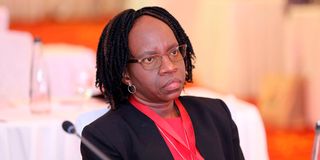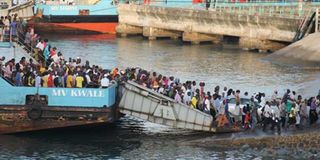Auditor-General Nancy Gathungu raises concerns over safety of Sh3.7 billion Likoni ferries

Auditor General Nancy Gathungu.
Auditor-General Nancy Gathungu has raised fears over the safety of the Sh3.7 billion ferries on the Likoni crossing channel in Mombasa noting that they expose users to the risk of death through accident without compensation as some are too old.
But even as she questioned the seaworthiness of the vessels at the crossing channel in a report before parliament, she has painted a grim picture of the financial situation at the Kenya Ports Authority (KPA).
She notes that the manual processing of revenue information exposes the parastatal to errors and losses at a time the government is working to fix revenue leakages in the system to fund its operations.
The fears by the Auditor-General are contained in the report on the audited accounts of KPA for the 2021/22 financial year that puts the management of KPA in a tight spot.
The audit says the institution took over the operation of seven ferries whose hull and machinery value as per the insurance records provided is Sh3.7 billion out of which three are over 30 years and may, therefore, be unseaworthy. “The KPA management did not provide evidence of seaworthiness of the marine vessels which are used to ferry citizens across the Likoni channel,” says the audit adding; “the users of the ferries are exposed to risk of loss of life or accident without compensation.”
The audit says although the institution realised Sh4.21 billion during the period under review, examination of revenue generation, recording and billing revealed weaknesses blamed on the manual recording of processes.

People disembark from MV Kwale ferry at the Likoni Channel.
Of the Sh4.21 billion KPA collected, Sh1.8 billion came from tug services dues, Sh615 million from pilotage, Sh607.51 million from dockage, Sh591.8 million in port dues, Sh335.64 million from mooring and Sh264.02 million in navigational dues.
“In the circumstances, the authority’s processes and procedures for pilotage, tug services dues, mooring, navigational dues, port dues and dockage are weak, which exposes the institution to errors and losses,” says the audit.
For instance, the audit discloses that on the provision of services to a vessel by KPA, details of such services are recorded manually on pilot log sheets by the pilot attending the vessel.
The audit says that the information is then manually collated and posted in the terminal operating system.
This is notwithstanding that KPA acquired and still retains and pays annual licenses to Vessel Traffic Management System (VTS) that should capture the indicated date and the same integrated with the main financial operating system.
“Despite continued maintenance and payment of annual licenses the VTS does not offer the expected services leaving the authority process prone or exposed to errors through manual data capture,” the audit reveals.
The current KPA tariff charges pilotage services per movements of the respective vessels.
However, the audit indicates that gas tankers take more time to navigate and maneuver within the harbour limits, meaning that pilots end up spending more time providing services to a single tanker “at the expense of others.”
“This is a clear indication of unfair tariff provision for the same service which may result in lost revenue if alternative charge models, like duration or on hourly basis are not applied,” the audit says.
The final billing records provided for audit indicated that some final bills are prepared long after the vessel has sailed away.
This is contrary to the requirement for collection of all bills before departure by the vessels, a manifestation of weaknesses at the facility that needs to be addressed.
The audit has further flagged the irregular promotion of staff at KPA by the National Treasury saying it borders on the usurpation of the powers of the KPA board.





